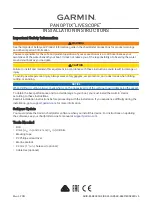
ALWAYS A STEP AHEAD
5
4
EN
3.1 Cable and device connection
Use the supplied connection cables only.
Start off by connecting the potential equalization cable (greenish-yellow marking) to ensure a
sufficient potential equalization between the unit and the user. The unit should not be operated in
medical areas without connecting up potential equalization.
Check to see whether your power grid has the correct voltage and frequency before connecting
the unit to the mains (refer to the nameplate on the housing). Afterwards, connect all of the nee-
ded cable connectors (such as mains cable, keyboard, mouse, serial cables, USB and network) to
the unit. To prevent the risk of electrical shock, this unit may only be connected to a supply system
with a protective earth. Attaching strain reliefs to the unit is not necessary for the customer.
If you want to completely disconnect the unit from the power system, turn off the mains switch or
pull the power plug from the outlet. Never pull on the cable and always hold onto the plug of the
cable when disconnecting the power system connections. Do not set up the unit under conditions
that impede the disconnection from the mains.
When creating an electrical connection with other devices or when operating the unit at a mobile
multiple outlet, compliance to the latest version of IEC 60601-1 has to be ensured. To maintain
conformity in this case so-called “decoupled connectors” are available for connections via RJ45,
RS232 or USB optionally. Data can be transferred through this galvanic isolation without any direct
electrical contact. From the electrical point of view the connection of medical equipment on these
decoupled connectors is admissible.
Furthermore, a functional unit is created by exchanging data with other devices, especially if this
functional unit is intended to be used for medical purpose (i.e. unit is controlling infusion pumps
or applied parts are connected). Validity of any assured properties nor conformity to standards
for the unit cannot be expanded to the newly created functional unit. Instead, the party which is
placing this unit on the market or in the clinical environment is responsible for its conformity with
all applicable standards..
There might be unforeseeable interactions or even malfunctions on one or both units if the unit is
connected to other units.
We would be glad to provide technical support and resolve unanswered questions.
Illustration: Example of a connector interface on the lower side of your OR-PC
®
Available connectors will vary depending on the configuration you have chosen for your unit.
Furthermore, appropriate ventilation is necessary to protect the unit from overheating and to
ensure reliable and continuous operation. This is the reason why the unit should not be put in a
place or under conditions where it is impossible to offer sufficient ventilation for the unit’s housing
surfaces. Finally, it is not allowed to place or suspend objects or materials on the unit to prevent
heat accumulation or an interruption of the air circulation and to protect the unit’s mounting from
excessive loads.
All service cables should be laid to make sure that nobody steps on them, trips over them or can
put heavy objects on them to prevent the hazard of injury and damage to the unit. Make sure that
there is a fixed location and/or stable suspension.
The industrial protection class of your unit can be upgraded up to IP65. If you have chosen this
optional upgrade, one of the central elements of the IP65-sealing is the cover for the connector
interface on the lower side of the unit. Connect all the required cables to the unit and insert them
into the rubber sealings (
blue
) delivered with the unit. Insert the sealings into the cover. Finally, fix
the cover to the unit’s housing like indicated on the drawings below (
orange
).





























